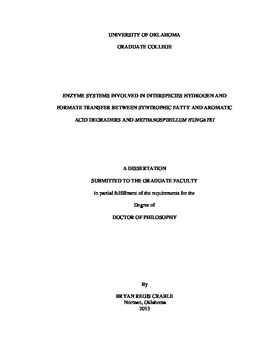| dc.description.abstract | The oxidation of either the fatty acid butyrate or the aromatic acid benzoate is essential for the efficient degradation of complex organic material to methane because they are central intermediates. The oxidation of butyrate to acetate and hydrogen is energy requiring under physiological conditions. Likewise, the oxidation of benzoate to acetate, carbon dioxide and hydrogen is energy requiring under physiological conditions. However, when hydrogen or formate are maintained at very low levels by a partner organism, through metabolic cooperation known as syntrophy, the oxidation of both butyrate and benzoate becomes energetically favorable. An essential feature of both the syntrophic oxidation of butyrate and benzoate is the need to produce hydrogen (E’ = -260 mV at 1 Pa hydrogen) or formate (E’ = -290 mV at 1 µM formate) from butyryl-CoA (butyrate oxidation by S. wolfei) or from glutaryl-CoA (benzoate oxidation by S. aciditrophicus). Ion gradients, and consequently membrane bound protein complexes, are known to be important for butyrate oxidation by S. wolfei and benzoate oxidation by bacteria related to S. aciditrophicus – Syntrophus gentianae and Syntrophus buswellii. The main goal of this research was to investigate the mechanisms of reverse electron transfer in S. wolfei and S. aciditrophicus. I used proteomic and enzymological approaches and coupled these approaches with mRNA expression analyses.
Here, I showed that an FeS oxidoreductase, the gene of which is linked on the chromosome to genes coding for electron transferring flavoprotein subunits, and components of a cytochrome b –linked hydrogenase (hydIIABC gene product) are codetected in a complex unique to syntrophic growth on butyrate. Expression analyses of the genes coding for the electron transferring flavoprotein subunits, FeS oxidoreductase and hydIIABC gene product argue for the importance of these systems for syntrophic growth on butyrate.
In S. aciditrophicus, I showed that peptides derived from an Rnf-like complex were detected in membrane complexes from S. aciditrophicus cells. I used the low potential acceptors, benzyl viologen (E0’ = -360 mV) and methyl viologen (E0’ = -460 mV) to test for the ability of S. aciditrophicus cells to catalyze an Rnf-like activity - reduction of the viologen dyes with NADH (E0’ = -320 mV). I showed that membrane fractions of S. wolfei catalyze the reduction of both benzyl and methyl viologen with electrons derived from NADH and that specific activity for this direction is higher than for the more thermodynamically favorable oxidation of benzyl or methyl viologen with concomitant reduction of NAD+. Moreover, I showed that the Rnf-like activity is highest in cells grown syntrophically. I used size exclusion chromatography to partially purify the Rnf-like activity and I showed that peptides derived from an Rnf-like complex are present in these fractions.
Finally, I investigated the genome of Methanospirillum hungatei strain JF1 and used whole cell shotgun proteomics to interrogate the response of M. hungatei to growth in syntrophic partnership with S. wolfei. M. hungatei is a hydrogenotrophic methanogen which is capable of utilizing formate or hydrogen for methane production. M. hungatei is a partner organism for several syntrophic systems and members of the genus Methanospirillum have been found in many environments where syntrophy is important. Proteomic analysis showed that M. hungatei uses both hydrogenases and formate dehydrogenases and increases the relative abundance of the core methanogenic machinery during syntrophic growth relative to pure culture growth on hydrogen and formate. The relative abundance of peptides associated with energy production and cofactor synthesis increased while those involved in translation decreased in syntrophically grown cells compared to axenically-grown cells. The above data are consistent with a strategy to maximize energy production efficiency and curtail biosynthesis during syntrophic growth. | en_US |
